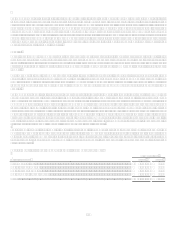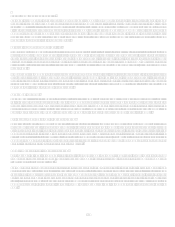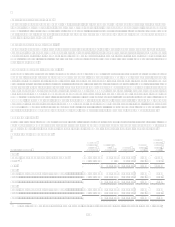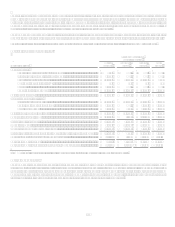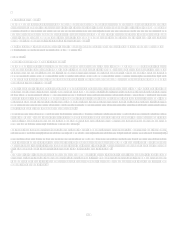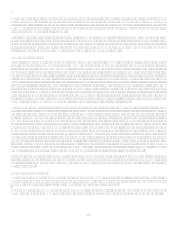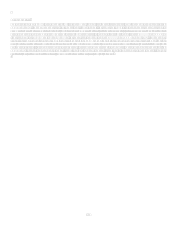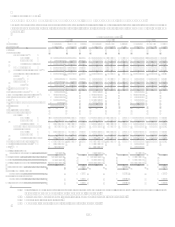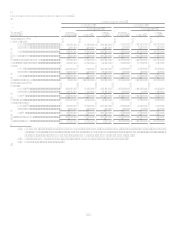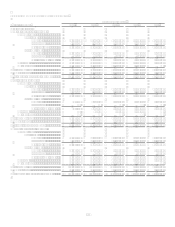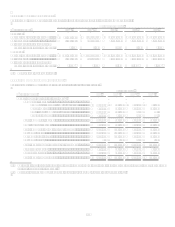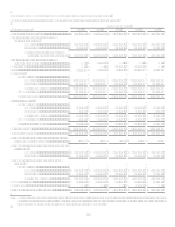Capital One 2008 Annual Report Download - page 88
Download and view the complete annual report
Please find page 88 of the 2008 Capital One annual report below. You can navigate through the pages in the report by either clicking on the pages listed below, or by using the keyword search tool below to find specific information within the annual report. 70
Derivative Instruments
The Company enters into interest rate swap agreements in order to manage interest rate exposure. In most cases, this exposure is
related to the funding of fixed rate assets with floating rate obligations, including off-balance sheet securitizations. The Company also
enters into forward foreign currency exchange contracts to reduce sensitivity to changing foreign currency exchange rates. The
hedging of foreign currency exchange rates is limited to certain intercompany obligations related to international operations. These
derivatives expose the Company to certain credit risks. The Company has established policies and limits, as well as collateral
agreements, to manage credit risk related to derivative instruments.
Additional information regarding derivative instruments can be found in Item 8 Financial Statements and Supplementary Data
Notes to the Consolidated Financial StatementsNote 17.
X. Capital
Federal Reserve and OCC Capital Standards
The Company is subject to capital adequacy guidance adopted by the Federal Reserve, and CONA and COBNA are subject to capital
adequacy guidelines adopted by the OCC. The capital adequacy guidelines set minimum risk-based and leverage capital requirements
that are based on quantitative and qualitative measures of their assets and off-balance sheet items. The Federal Reserve holds the
Company to similar minimum capital requirements. Failure to meet minimum capital requirements can result in possible additional,
mandatory or discretionary actions by the regulators that, if undertaken, could have a material adverse effect on the Companys
consolidated financial statements.
Under these guidelines, a banks or a holding companys assets and certain specified off-balance sheet commitments and obligations
are assigned to various risk categories. A banks or holding companys capital, in turn, is classified in one of three tiers. Tier 1 capital
includes, among other things, common equity, non-cumulative perpetual preferred stock, an eligible amount of cumulative perpetual
preferred stock at the holding company level, and minority interests in equity accounts of consolidated subsidiaries, less goodwill and
certain other deductions. Tier 2 capital includes, among other things, perpetual preferred stock not qualified as Tier 1 capital, a certain
amount of subordinated debt and the allowable portion of allowances for loan and lease losses, subject to certain limitations. Tier 3
capital includes qualifying unsecured subordinated debt.
Banks and bank holding companies currently are required to maintain Tier 1 capital and the sum of Tier 1 and Tier 2 capital equal to
at least 4% and 8%, respectively, of their total risk-weighted assets (including certain off-balance sheet items, such as standby letters
of credit). The federal banking agencies, however, may set higher capital requirements for an individual bank or bank holding
company when a banks particular circumstances warrant.
The federal banking agencies also require incorporation of market components into regulatory capital computations. Under the market
risk requirements, capital is allocated to support the amount of market risk related to a financial institutions ongoing trading activities.
In addition, the federal banking agencies have established minimum leverage (Tier 1 capital to adjusted average total assets)
guidelines for banks within their regulatory jurisdiction. These guidelines provide for a minimum leverage ratio of 3% for banks that
meet certain specified criteria, including excellent asset quality, high liquidity, low interest rate exposure and the highest regulatory
rating. Banks not meeting these criteria are required to maintain a leverage ratio of 4%.
From time to time, the regulators propose changes and amendments to, and issue interpretations of, risk-based capital guidelines and
related reporting instructions. Such proposals or interpretations could, if implemented in the future, affect the Companys or each of
the Banks reported capital ratios and net risk-adjusted assets. For additional information on capital guidelines, see Part I, Item 1
Supervision and Regulation.




